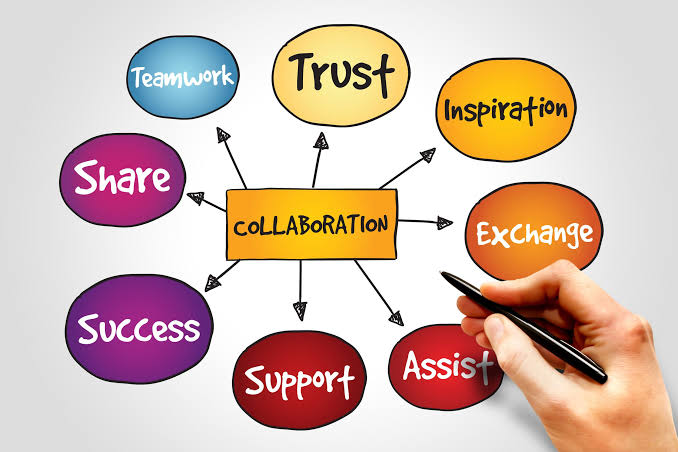আধুনিক কর্মক্ষেত্রগুলিতে সহযোগিতা (Collaboration) হলো সাফল্যের মূল ভিত্তি। যখন কর্মীরা কার্যকরভাবে একসঙ্গে কাজ করেন, তখন তারা আরও বেশি কিছু অর্জন করতে পারেন, উদ্ভাবনী ধারণা তৈরি করতে পারেন এবং একটি ইতিবাচক কাজের পরিবেশ গড়ে তুলতে পারেন। তবে, কর্মীদের মধ্যে সহযোগিতার প্রবণতা অনুকূল করতে একটি সুচিন্তিত পদ্ধতির প্রয়োজন, যার মধ্যে একটি সহায়ক কর্মক্ষেত্রের সংস্কৃতি তৈরি করা, কার্যকর যোগাযোগ চ্যানেল প্রয়োগ করা এবং দলগত কাজকে উৎসাহিত করা অন্তর্ভুক্ত। এই প্রবন্ধে আমরা কর্মীদের মধ্যে সহযোগিতার প্রবণতা বাড়ানোর কৌশলগুলি অন্বেষণ করব, যা উন্নত উৎপাদনশীলতা এবং সামগ্রিক সাফল্যের দিকে পরিচালিত করবে।
১. সহযোগিতার সংস্কৃতি তৈরি
একটি সহযোগী কাজের সংস্কৃতি তৈরি করা কর্মীদের স্বাভাবিকভাবে সহযোগিতা করতে উৎসাহিত করার জন্য অপরিহার্য। নিম্নলিখিত পদ্ধতিগুলি একটি সহযোগী পরিবেশ গড়ে তুলতে সাহায্য করতে পারে:
ক. সাধারণ লক্ষ্য: স্পষ্ট এবং সাধারণ লক্ষ্য স্থাপন করুন যা দলগত কাজ এবং ভাগ করা সাফল্যের ওপর জোর দেয়। কর্মীদের তাদের ব্যক্তিগত উদ্দেশ্যগুলিকে বৃহত্তর সাংগঠনিক লক্ষ্যের সঙ্গে সারিবদ্ধ করতে উৎসাহিত করুন।
খ. উন্মুক্ত যোগাযোগে উৎসাহ: দলের সদস্যদের মধ্যে এবং বিভাগজুড়ে খোলামেলা কথোপকথনকে উৎসাহিত করুন। ধারণা, প্রতিক্রিয়া এবং উদ্বেগ ভাগ করে নেওয়ার জন্য নিয়মিত চ্যানেল স্থাপন করুন, যাতে প্রত্যেকের বক্তব্য শোনা যায়।
গ. উদাহরণ তৈরি করুন (Lead by Example): নেতাদের উচিত দলগত আলোচনায় সক্রিয়ভাবে অংশ নেওয়া, কর্মীদের কাছ থেকে মতামত নেওয়া এবং বিভিন্ন দৃষ্টিকোণকে মূল্য দেওয়ার মাধ্যমে সহযোগী আচরণের মডেল তৈরি করা। নেতারা যখন সহযোগিতা প্রদর্শন করেন, তখন এটি পুরো সংস্থার জন্য একটি ইতিবাচক সুর সেট করে।
২. বিশ্বাস এবং মনস্তাত্ত্বিক সুরক্ষা তৈরি
বিশ্বাস হলো কার্যকর সহযোগিতার ভিত্তি। এমন একটি পরিবেশ তৈরি করুন যেখানে কর্মীরা বিচার বা প্রতিশোধের ভয় ছাড়াই ধারণা ভাগ করে নিতে, ঝুঁকি নিতে এবং তাদের মতামত প্রকাশ করতে মনস্তাত্ত্বিকভাবে সুরক্ষিত বোধ করেন।
ক. সম্মান এবং স্বীকৃতি: বিভিন্ন দক্ষতা এবং পটভূমির প্রতি সম্মান ও প্রশংসার সংস্কৃতিকে উৎসাহিত করুন। কর্মীদের মনোবল বাড়াতে এবং বিশ্বাস গড়ে তুলতে ব্যক্তিগত ও দলগত অর্জনগুলিকে স্বীকৃতি দিন এবং উদযাপন করুন।
খ. গঠনমূলক প্রতিক্রিয়া: এমন একটি প্রতিক্রিয়া-ভিত্তিক সংস্কৃতিকে প্রচার করুন যেখানে প্রতিক্রিয়া বা ফিডব্যাককে বৃদ্ধির সুযোগ হিসাবে দেখা হয়। কর্মীদের গঠনমূলক সমালোচনা এবং উন্নতির জন্য পরামর্শ দিতে উৎসাহিত করুন।
গ. দল-গঠন কার্যক্রম (Team-Building Activities): আন্তঃব্যক্তিক সম্পর্ক বাড়াতে, বিশ্বাস তৈরি করতে এবং সহযোগিতা বাড়াতে দল-গঠন অনুশীলন এবং কার্যক্রমের আয়োজন করুন।1
৩. সহযোগী সরঞ্জাম এবং প্রযুক্তি সরবরাহ
কর্মক্ষেত্রে সহযোগিতা সহজ করতে এবং যোগাযোগকে সুগম করতে প্রযুক্তির ব্যবহার করুন।
ক. প্রকল্প ব্যবস্থাপনা সরঞ্জাম: এমন প্রকল্প ব্যবস্থাপনা প্ল্যাটফর্ম প্রয়োগ করুন যা দলগুলিকে রিয়েল-টাইমে সহযোগিতা করতে, কাজ বরাদ্দ করতে, অগ্রগতি ট্র্যাক করতে এবং ফাইল ভাগ করে নিতে সহায়তা করে। এই সরঞ্জামগুলি স্বচ্ছতা বাড়ায়।
খ. ভার্চুয়াল সহযোগিতা সরঞ্জাম: যদি আপনার কর্মীরা দূরবর্তী বা বিতরণ করা হয়, তবে দূরত্ব কমাতে এবং নির্বিঘ্ন যোগাযোগ সক্ষম করতে ভিডিও কনফারেন্সিং, ইনস্ট্যান্ট মেসেজিং এবং ভার্চুয়াল সহযোগিতা প্ল্যাটফর্ম সরবরাহ করুন।
৪. ক্রস-ফাংশনাল সহযোগিতা উৎসাহিত
সাইলো ভেঙে দেওয়া এবং ক্রস-ফাংশনাল সহযোগিতা উৎসাহিত করা নতুন দৃষ্টিভঙ্গি, উদ্ভাবন বৃদ্ধি এবং উন্নত সমস্যা সমাধানের সক্ষমতার দিকে নিয়ে যেতে পারে।
ক. আন্তঃ-বিভাগীয় প্রকল্প: বিভিন্ন বিভাগ থেকে কর্মীদের একসাথে প্রকল্পে কাজ করার জন্য নিযুক্ত করুন, যা দলগুলির মধ্যে জ্ঞান ভাগ করে নেওয়া এবং সহযোগিতাকে উৎসাহিত করবে।
খ. ভাগ করা কর্মক্ষেত্র: শারীরিক বা ভার্চুয়াল স্থান ডিজাইন করুন যা বিভিন্ন দল বা বিভাগের কর্মীদের মধ্যে স্বতঃস্ফূর্ত মিথস্ক্রিয়া এবং সহযোগিতাকে প্রচার করে।
৫. সহযোগিতা স্বীকৃতি এবং পুরস্কৃত করুন
সহযোগিতার প্রচেষ্টায় সক্রিয়ভাবে অংশগ্রহণকারী ব্যক্তি এবং দলগুলিকে স্বীকৃতি দিন এবং পুরস্কৃত করুন। এটি সহযোগিতার গুরুত্বকে জোরদার করে এবং কর্মীদের কার্যকরভাবে একসাথে কাজ চালিয়ে যেতে অনুপ্রাণিত করে।
ক. প্রণোদনা কর্মসূচি: প্রণোদনা কর্মসূচি প্রয়োগ করুন যা সহযোগিতাকে উৎসাহিত করে এবং সম্মিলিত অর্জনগুলিকে পুরস্কৃত করে। এর মধ্যে বোনাস, স্বীকৃতি কর্মসূচি, বা দলগত কর্মক্ষমতার সাথে যুক্ত অন্যান্য প্রণোদনা অন্তর্ভুক্ত থাকতে পারে।
খ. প্রকাশ্যে স্বীকৃতি: অভ্যন্তরীণ নিউজলেটার, মিটিং বা কোম্পানি-ব্যাপী যোগাযোগ চ্যানেলের মাধ্যমে সহযোগী সাফল্যগুলি ভাগ করে নিয়ে সেগুলি উদযাপন করুন।
উপসংহার
একটি সহযোগী কাজের সংস্কৃতি গড়ে তোলা, বিশ্বাস তৈরি করা, সহযোগী সরঞ্জাম সরবরাহ করা, ক্রস-ফাংশনাল সহযোগিতা উৎসাহিত করা এবং দলগত কাজের স্বীকৃতি দেওয়ার মাধ্যমে সংস্থাগুলি কর্মীদের মধ্যে সহযোগিতার প্রবণতা অনুকূল করতে পারে। উন্নত সহযোগিতার সুবিধাগুলির মধ্যে রয়েছে উদ্ভাবন বৃদ্ধি, দ্রুত সমস্যা সমাধান এবং সামগ্রিক সাংগঠনিক সাফল্য।







মন্তব্য করুন